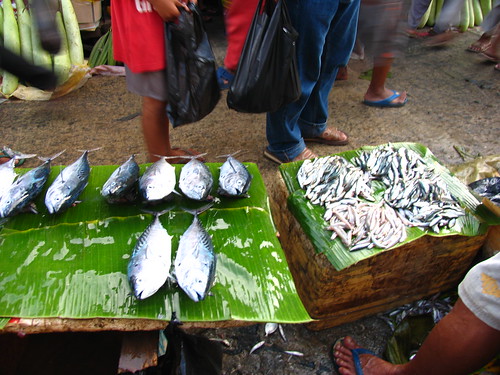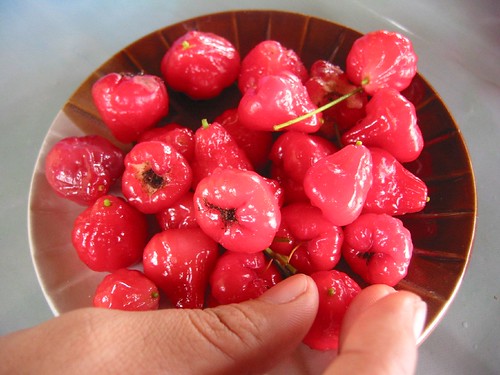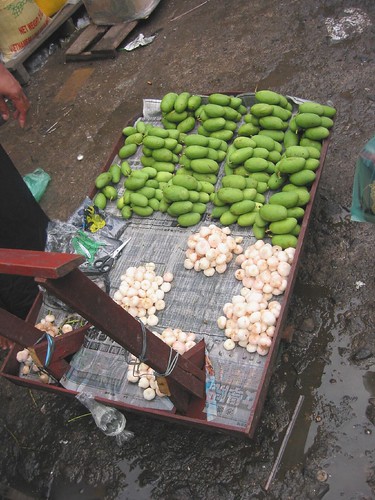Bongao eats
Bongao, the capital town of Tawi-Tawi, the Philippines’ southernmost province, is far from your typical urban center in the country. Not at all dense in population, it is a town that is constantly developing and growing. Accommodations are modest and communication facilities are basic.
Food is another matter though. While it does not feature fancy restaurants of high name recall, Bongao is inarguably a haven of fresh seafood that come straight from the boats. From tunas to mackerel and prawns to crabs, the bounty of sea spills in the market.

the catch of the day is paraded in the Chinese Pier, Bongao, Tawi-Tawi (photo taken by my wife)
Canon PowerShot Pro1, 1/10s, f/2.4, 7.2mm
Whether you have your seafood in the small eateries or cooked in the home of a local, little else matters when they come as fresh as they do in Bongao.

some shellfishes, like the sea urchins above, are available all throughout the island (photo taken by my wife)
Canon PowerShot Pro1, 1/125s, f/4, 50.8mm
Food seems to be a street affair in Bongao. Ready to eat comestibles are everywhere in the streets, particularly near the Chinese Pier of Bongao which in anytime of the day is filled with the aroma of grilled and fried food.

a typical barbecue stall at Bongao
Canon PowerShot S40, 1/800s, f/2.8, 7.1mm

the ukoy-ukoy or vegetable cakes are commonly cooked and peddled in the streets by the Chinese Pier
Canon PowerShot S40, 1/1000s, f/2.8, 7.1mm
There is a sizeable Christian population in Bongao, estimated to be near 40%, but to skirt Muslim sensibilities, pork consumption is still discreetly done. Most eateries are halal and Christian and Muslim delicacies are normally offered side by side. Nevertheless, the not-so-secret delicacy of Bongao is cured meat from wild boars which roam freely in the hinterlands. I’ve never done this in the three or four times I’ve been to Bongao, but they say that you have to order a day ahead to partake of the gourmet dried tapas.

traditional Muslim and Christian cakes and bread at a carenderia by the Chinese pier, Bongao
Canon PowerShot S40, 1/250s, f/2.8, 7.1mm
Muslims in Bongao are either Tausug, Samal or Badjaos. The predominant group is the Samal, reputed for their peace-loving demeanor. The typical staple is cassava, which they pound and ground and sell as panggi and this starch basic is found everywhere in the Chinese Pier.

the panggi, a ground cassava staple of the native Sama and Badjaos
Canon EOS 350D Digital, 1/200s, f/4.5, 34mm, ISO 100

a bunch of bianban cassava cake sold at the Sanga-Sanga airport, Bongao
Canon PowerShot S40, 1/125s, f/2.8, 7.1mm
But perhaps the most curious item I remembered so well were the tiny roseapple fruits, or tambis in Cebuano. They were the smallest I have ever seen but they were no less juicy and sweet.

the miniature tambis or roseapple variety in Bongao is the smallest I have ever seen yet
Canon PowerShot S40, 1/40s, f/2.8, 7.1mm
To date, I haven’t seen anything smaller than they were in Bongao. Miniature can occasionally be better than the ordinary.

more roseapples (tambis) but in paler pink, with some green mangoes at Bongao
Canon PowerShot S40, 1/1000s, f/2.8, 7.1 mm






No comments:
Post a Comment